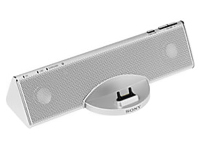 There was a time when the word ‘dock’ only conjured up visions of dirty great harbours full of ships, cranes, an angry Marlon Brando and beefy tattooed blokes lugging great sacks around the place.
There was a time when the word ‘dock’ only conjured up visions of dirty great harbours full of ships, cranes, an angry Marlon Brando and beefy tattooed blokes lugging great sacks around the place.
But to your average teenager, a ‘dock’ is now simply something they slam their phone or iPod into for recharging or connecting to their computer, and keen to keep up the connection, Sony Ericsson have just announced a new docking wotsit for their phones, the MP001.
It’s not going to be battling for design awards, but it’s an attractive enough device (as docking cradles go) and capable of belting out a very reasonable 25W (RMS) of sound through the built-in amp and speakers.
Powering the silver, triangular dock is Sony’s very own S-Master Digital amplifier, with onboard digital signal processing (DSP) keeping the sounds sweet.
This is the very same amplifier found in some Sony home cinema kits and car audio systems and, coupled with the built in sub-woofer speaker, there’s a good chance that this mini system will make a decent racket for its size.
 So long as your phone has a FM tuner, it can be activated as soon as you plonk the handset into the cradle, letting the MP001 double up as a home radio system – neat.
So long as your phone has a FM tuner, it can be activated as soon as you plonk the handset into the cradle, letting the MP001 double up as a home radio system – neat.
Naturally, the phone is automatically charged while you’re getting on down to your sounds and long-term sofa residents will appreciate the bundled basic remote control offering volume, bass and treble control.
Daniel Svoboda, Sony Ericsson’s General Manager, Home Electronics Marketing Europe was suitably enthusiastic, “Something like this is perfect for so many types of people. Teenagers, students, office workers, basically anyone who wants to use their music phone to the full.”
The MP001 is only compatible with Sony Ericsson music phones with Fast Port and is due to go on sale in the UK around June. No word on pricing or availability yet.
 To find out how secure Apple’s OS X operating system is, a Swedish-based Mac fan set up his Mac Mini on the Internet, and invited hackers to try and break through the computer’s security and gain root control.
To find out how secure Apple’s OS X operating system is, a Swedish-based Mac fan set up his Mac Mini on the Internet, and invited hackers to try and break through the computer’s security and gain root control. Dave Schroeder of the University of Wisconsin explained that because anyone logging on was allowed to set up a local account on the Swedish machine (accessed via ssh), the exercise was more like breaking into a different user account while sat behind the computer. And that is much easier then hacking into a fully protected system over the Internet.
Dave Schroeder of the University of Wisconsin explained that because anyone logging on was allowed to set up a local account on the Swedish machine (accessed via ssh), the exercise was more like breaking into a different user account while sat behind the computer. And that is much easier then hacking into a fully protected system over the Internet. There may be almost 76 million sites stuffed full of six billion pages of information vying for our attention on the Web, but it seems that most surfers only choose to visit six sites on a regular basis.
There may be almost 76 million sites stuffed full of six billion pages of information vying for our attention on the Web, but it seems that most surfers only choose to visit six sites on a regular basis. Sadly, it seems that the days of random surfing are coming to a close, with the vast majority of Web users (95 per cent) going online with a specific destination in mind.
Sadly, it seems that the days of random surfing are coming to a close, with the vast majority of Web users (95 per cent) going online with a specific destination in mind.  Bringing together public services from across eleven Whitehall departments, visitors to Directgov can unearth a mountain of useful information and services, from renewing driving licences, car taxes or passports , locating local services like schools, childminders and recycling and even planning journeys on foot, by car or by public transport.
Bringing together public services from across eleven Whitehall departments, visitors to Directgov can unearth a mountain of useful information and services, from renewing driving licences, car taxes or passports , locating local services like schools, childminders and recycling and even planning journeys on foot, by car or by public transport.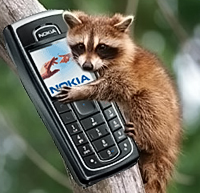 With a bonkers new naming strategy that suggests the creatives may have been on something stronger than caffeine, Orange have launched a new tariff that links customer behaviour with animal characteristics.
With a bonkers new naming strategy that suggests the creatives may have been on something stronger than caffeine, Orange have launched a new tariff that links customer behaviour with animal characteristics.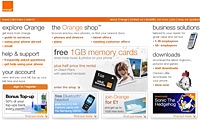 Initially launching to Pay Monthly customers, the animal packages will be made available to Pay as you go customers later in the year.
Initially launching to Pay Monthly customers, the animal packages will be made available to Pay as you go customers later in the year.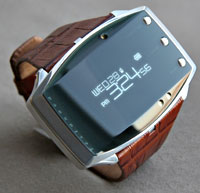 Seiko Instruments has announced their first Bluetooth watch, known as either the BT Watch or the rather less snappy, CPC TR-006 ver.1.0.
Seiko Instruments has announced their first Bluetooth watch, known as either the BT Watch or the rather less snappy, CPC TR-006 ver.1.0. If you get an SMS or email on your phone the watch can alert you, and if your phone’s ringing, you won’t have to rummage about in your bag or pockets to see who is calling – the number will appear on the watch.
If you get an SMS or email on your phone the watch can alert you, and if your phone’s ringing, you won’t have to rummage about in your bag or pockets to see who is calling – the number will appear on the watch.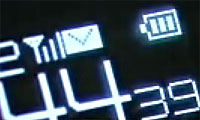 Now, much as we like the idea of cool high tech toys buzzing away on our wrists, we have to say that this watch looks more than a bit silly – it’s so big you may as well strap your mobile onto your wrist and be done with it!
Now, much as we like the idea of cool high tech toys buzzing away on our wrists, we have to say that this watch looks more than a bit silly – it’s so big you may as well strap your mobile onto your wrist and be done with it!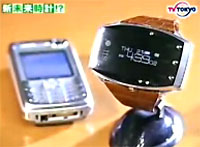 We reckon it would be cool to have text messages, news headlines, RSS feeds, football scores and other short bursts of info appear on your watch – particularly when you’re stuck in a dull meeting.
We reckon it would be cool to have text messages, news headlines, RSS feeds, football scores and other short bursts of info appear on your watch – particularly when you’re stuck in a dull meeting.  BT has announced that some of its users should be able to obtain broadband speeds of ‘up to’ 8 Mbps by the end of March.
BT has announced that some of its users should be able to obtain broadband speeds of ‘up to’ 8 Mbps by the end of March. All good news you’d think, but the new connectivity comes with a bag full of caveats related to physical factors, with only those lucky enough to live or work close to their local telephone exchange able to scoop up the maximum 8Mbit/s speed.
All good news you’d think, but the new connectivity comes with a bag full of caveats related to physical factors, with only those lucky enough to live or work close to their local telephone exchange able to scoop up the maximum 8Mbit/s speed.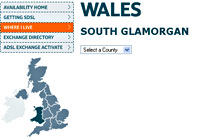 Paul Reynolds, BT’s Wholesale chief executive, was keen to big up his company’s commitment to broadband availability in the UK “Thanks to BT’s continued investment in the broadband network, the UK now boasts the highest level of broadband availability in the G8. We’re now building on those efforts in becoming the first operator in the UK to commit to a national service which is capable of broadband speeds of up to 8Mbit/s.
Paul Reynolds, BT’s Wholesale chief executive, was keen to big up his company’s commitment to broadband availability in the UK “Thanks to BT’s continued investment in the broadband network, the UK now boasts the highest level of broadband availability in the G8. We’re now building on those efforts in becoming the first operator in the UK to commit to a national service which is capable of broadband speeds of up to 8Mbit/s.  Those clever Koreans at LG are at it again, releasing the ONE PHONE II, a smart new Bluetooth home/mobile phone and the XNOTE TX, a tiny laptop with a built in DMB module.
Those clever Koreans at LG are at it again, releasing the ONE PHONE II, a smart new Bluetooth home/mobile phone and the XNOTE TX, a tiny laptop with a built in DMB module.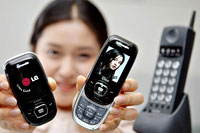 It appears that this phone, however, uses the technology to automatically switch to a landline and not a Wi-Fi home network like the Fusion.
It appears that this phone, however, uses the technology to automatically switch to a landline and not a Wi-Fi home network like the Fusion.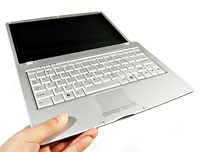 Packed inside its ultra-thin body is 12.1-inch, 1366×768 pixel LCD, a 1.3GHz Intel Pentium-M processor, Geforce Go 7300 graphics, a healthy 60GB disk with support for up to 2GB RAM.
Packed inside its ultra-thin body is 12.1-inch, 1366×768 pixel LCD, a 1.3GHz Intel Pentium-M processor, Geforce Go 7300 graphics, a healthy 60GB disk with support for up to 2GB RAM.  Battery life is quoted around a disappointing 2 hours (up to 8 hours with additional battery), although this plummets down to just 1hr 12 mins if you’re using the attached optical drive.
Battery life is quoted around a disappointing 2 hours (up to 8 hours with additional battery), although this plummets down to just 1hr 12 mins if you’re using the attached optical drive. We have to say we’re mightily impressed with the desirability factor of the so-small-you-want-to-pat-them-on-the-head XNOTEs and it’s great to see LG coming up with design to rival Apple/Sony’s finest.
We have to say we’re mightily impressed with the desirability factor of the so-small-you-want-to-pat-them-on-the-head XNOTEs and it’s great to see LG coming up with design to rival Apple/Sony’s finest.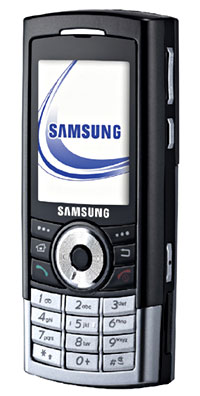 Samsung has announced the world’s first 8GB Hard Disk embedded smartphone, the SGH-i310, which is expected to start shipping in Europe during the second half of this year.
Samsung has announced the world’s first 8GB Hard Disk embedded smartphone, the SGH-i310, which is expected to start shipping in Europe during the second half of this year.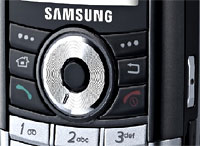 The smartphone seems pretty pocketable too, measuring 111.9 x 48.5 x 19.8 mm and weighing 120g.
The smartphone seems pretty pocketable too, measuring 111.9 x 48.5 x 19.8 mm and weighing 120g.